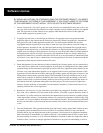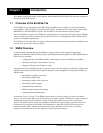
18 EuroPak-15a Receiver User Manual Rev 5
Chapter 1 Introduction
The fully deployed Galileo system consists of 30 satellites (27 operational + 3 active spares), positioned in
three circular Medium Earth Orbit (MEO) planes in 23616 km altitude above the Earth, and at an inclination of
the orbital planes of 56 degrees with reference to the equatorial plane. Once this is achieved, the Galileo
navigation signals will provide a good coverage even at latitudes up to 75 degrees north, which corresponds to
the North Cape, and beyond. The large number of satellites together with the optimization of the constellation,
and the availability of the three active spare satellites, will ensure that the loss of one satellite has no discernible
effect on the user.
Two Galileo Control Centres (GCC) will be implemented on European ground to provide for the control of the
satellites and to perform the navigation mission management. The data provided by a global network of twenty
Galileo Sensor Stations (GSS) will be sent to the Galileo Control Centres through a redundant communications
network. The GCC's will use the data of the Sensor Stations to compute the integrity information and to
synchronize the time signal of all satellites and of the ground station clocks. The exchange of the data between
the Control Centres and the satellites will be performed through so-called up-link stations. Five S-band up-link
stations and 10 C-band up-link stations will be installed around the globe for this purpose.
As a further feature, Galileo will provide a global Search and Rescue (SAR) function, based on the operational
search and rescue satellite aided tracking Cospas-Sarsat system. To do so, each satellite will be equipped with a
transponder, which is able to transfer the distress signals from the user transmitters to the Rescue Co-ordination
Centre (RCC), which will then initiate the rescue operation. At the same time, the system will provide a signal
to the user, informing them that their situation has been detected and that help is under way. This latter feature
is new and is considered a major upgrade compared to the existing system, which does not provide a feedback
to the user.
Five categories of services have been defined:
1. A free Open Service (OS)
2. A highly reliable Commercial Service (CS)
3. A Safety-of-Life Service (SOL)
4. A government encrypted Public Regulated Service (PRS)
5. A Search and Rescue Service (SAR)
1.3.1 Open Service
This single-frequency service will involve the provision of a positioning, navigation and precise timing service.
It will be available for use by any person in possession of a Galileo receiver. No authorization will be required
to access this service. Galileo is expected to be similar to GPS in this respect.
The principal applications will be general navigation and positioning, network timing, traffic information
systems, systems including information on alternative routes in the event of congestion, and wireless location,
for example, with mobile telephones.
Studies clearly show that the availability of these services will be significantly enhanced by the existence of a
greater number of satellites, as is the case when both GPS and Galileo are in operation. This is particularly
important for land-based services, such as private car navigation, where service is mostly required in downtown
cores and where satellite shadowing is minimized by the combination of the systems.
The Open Service will be transmitted in the E5a frequency band at 1176.45 MHz.
1.3.2 Commercial Service
Service providers using the multi-frequency commercial services will have the opportunity to give added value
to their range of products for which they can charge the end customer and will, in turn, pay a fee to the Galileo
operator. The signal will contain data relating to the additional commercial services being offered. In return for
the fee, the Galileo operator will be able to offer certain service guarantees. This aspect of service guarantee
and the commensurate liabilities is one area where Galileo is significantly differentiated from GPS. A key
component in achieving this is an independent system within Galileo for monitoring the satisfactory working of


















